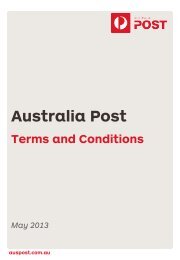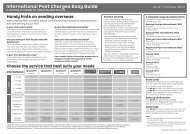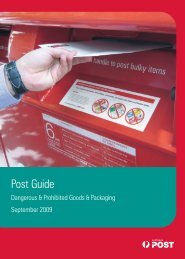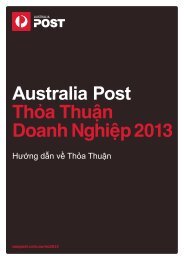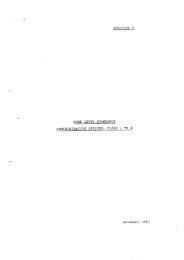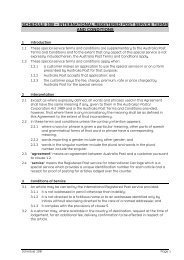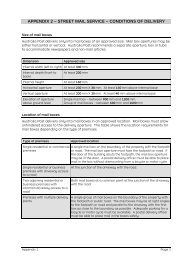2009-10 Annual Report - Australia Post
2009-10 Annual Report - Australia Post
2009-10 Annual Report - Australia Post
You also want an ePaper? Increase the reach of your titles
YUMPU automatically turns print PDFs into web optimized ePapers that Google loves.
notes to And ForminG PArt oF the FinAnCiAl rePort For the year ended 30 June 20<strong>10</strong><br />
an item of property, plant and equipment is derecognised upon disposal<br />
or when no further future economic benefits are expected from its use<br />
or disposal. any gain or loss arising on derecognition of the asset<br />
(calculated as the difference between the net disposal proceeds and the<br />
carrying amount of the asset) is included in the statement of<br />
comprehensive income in the year in which the asset is derecognised.<br />
depreciable property, plant and equipment assets are written off to<br />
their estimated residual values over their estimated useful lives using<br />
the straight-line method of depreciation.<br />
depreciation rates (useful lives) and methods are reviewed annually<br />
and necessary adjustments are recognised in the current, or current<br />
and future reporting periods, as appropriate.<br />
depreciation rates applying to items in each class of depreciable asset<br />
are based on the following useful lives:<br />
54<br />
20<strong>10</strong> <strong>2009</strong><br />
Buildings – Gpos 70 years 70 years<br />
Buildings – other facilities 40–50 years 40–50 years<br />
leasehold improvements lower of lease<br />
term and <strong>10</strong> years<br />
lower of lease<br />
term and <strong>10</strong> years<br />
Motor vehicles 3–<strong>10</strong> years 3–<strong>10</strong> years<br />
specialised plant and equipment <strong>10</strong>–20 years <strong>10</strong>–20 years<br />
other plant and equipment 3–<strong>10</strong> years 3–<strong>10</strong> years<br />
the aggregate amount of depreciation allocated for each class<br />
of asset during the reporting period is disclosed in note 3.<br />
(t) investment properties<br />
investment properties are measured initially at cost, including<br />
transaction costs. the carrying amount includes the cost of replacing<br />
part of an existing investment property at the time that cost is incurred<br />
if the recognition criteria are met and excludes the costs of day-to-day<br />
servicing of an investment property. subsequent to initial recognition,<br />
investment properties are measured at fair value, which is based on<br />
active market prices, adjusted if necessary, for any difference in the<br />
nature, location or condition of the specific asset at the reporting date.<br />
Gains or losses arising from changes in the fair values of investment<br />
properties are recognised in profit or loss in the year in which they arise.<br />
investment properties are derecognised either when they have been<br />
disposed of or when the investment property is permanently withdrawn<br />
from use and no future economic benefit is expected from its disposal.<br />
any gains or losses on the retirement or disposal of an investment property<br />
are recognised in profit or loss in the year of retirement or disposal.<br />
transfers are made to investment property when there is a change in<br />
use, evidenced by ending of owner-occupation, commencement of an<br />
operating lease to another party. transfers are made from investment<br />
property when and only when, there is a change in use, evidenced by<br />
commencement of owner-occupation or commencement of<br />
development with a view to sale.<br />
For a transfer from investment property to owner-occupied property or<br />
inventories, the deemed cost of property for subsequent accounting is<br />
its fair value at the date of change in use. if the property occupied by the<br />
group as an owner-occupied property becomes an investment property,<br />
the group accounts for such property in accordance with the policy<br />
stated under property, plant and equipment up to the date of change<br />
in use.<br />
AustrAliA <strong>Post</strong> AnnuAl rePort <strong>2009</strong>–<strong>10</strong> | Financial and statutory reports<br />
(u) investments and other financial assets<br />
investments and financial assets in the scope of aasB 139: Financial<br />
Instruments: Recognition and Measurement are categorised as either<br />
financial assets at fair value through profit or loss, loans and receivables,<br />
held-to-maturity investments or available-for-sale financial assets. the<br />
classification depends on the purpose for which the investments were<br />
acquired or originated. designation is re-evaluated at each financial year<br />
end, but there are restrictions on reclassifying to other categories. When<br />
financial assets are recognised initially, they are measured at fair value<br />
plus, in the case of assets not at fair value through profit or loss, directly<br />
attributable transactions costs.<br />
recognition and derecognition<br />
all regular way purchases and sales of financial assets are recognised<br />
on the trade date; that is, the date on which the group commits to<br />
purchase the asset. regular way purchases or sales are purchases<br />
or sales of financial assets under contracts that require delivery of<br />
the assets within the period established generally by regulation or<br />
convention in the marketplace. Financial assets are derecognised when<br />
the right to receive cashflows from the financial assets have expired or<br />
when the entity transfers substantially all the risks and rewards of the<br />
financial assets. if the entity neither retains nor transfers substantially all<br />
of the risks and rewards, it derecognises the asset if it has transferred<br />
control of the asset.<br />
subsequent measurement<br />
(i) Financial assets at fair value through profit or loss<br />
Financial assets classified as held for trading are included in the category<br />
“financial assets at fair value through profit or loss”. Financial assets<br />
are classified as held for trading if they are acquired for the purpose of<br />
selling in the near term with the intention of making a profit. derivatives<br />
are also classified as held for trading unless they are designated as<br />
effective hedging instruments. Gains or losses on financial assets<br />
held for trading are recognised in profit or loss.<br />
(ii) held-to-maturity investments<br />
non-derivative financial assets with fixed or determinable payments and<br />
fixed maturity are classified as held-to-maturity when the group has the<br />
positive intention and ability to hold to maturity. investments intended<br />
to be held for an undefined period are not included in this classification.<br />
investments that are intended to be held-to-maturity, such as bonds, are<br />
subsequently measured at amortised cost. this cost is computed as the<br />
amount initially recognised minus principal repayments, plus or minus<br />
the cumulative amortisation using the effective interest method of any<br />
difference between the initially recognised amount and the maturity<br />
amount. this calculation includes all fees and points paid or received<br />
between parties to the contract that are an integral part of the effective<br />
interest rate, transaction costs and all other premiums and discounts.<br />
For investments carried at amortised cost, gains and losses are<br />
recognised in profit or loss when the investments are derecognised<br />
or impaired, as well as through the amortisation process.<br />
(iii) loans and receivables<br />
loans and receivables are non-derivative financial assets with fixed or<br />
determinable payments that are not quoted in an active market. such<br />
assets are carried at amortised cost using the effective interest rate<br />
method. Gains and losses are recognised in profit or loss when the loans<br />
and receivables are derecognised or impaired, as well as through the<br />
amortisation process. these are included in current assets, except those<br />
with maturities greater than 12 months after balance date, which are<br />
classified as non-current.




